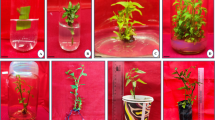Abstract
An efficient liquid culture system for plant regeneration from leaflessstem–root axes of Cryptanthus sinuosus L. B. Smith(Bromeliaceae) was established. High regeneration rates (93%) were achieved inMurashige and Skoog's medium without growth regulators. Whole plants wereobtained in a single-step procedure, resulting in the production of 25.3± 3.6 plants/explant after 6 months of culture. Incubationof plant material at 35 ± 3 °C resulted in an increaseof 60% in the regeneration efficiency compared with tissues incubated at 28± 2 °C. Moreover, after 5–6 sub-cultures in thesame medium, the axes originated bud clusters that could be continuouslymultiplied and gave rise to 19.4 ± 3.2 whole plants per gram of freshmatter. It was estimated that the liquid culture system described is potentiallyable to produce about 4500 plants/explant/year. Rates of 98% acclimatizationwere achieved. The use of plants produced following this method for populationreinforcement and for in vitro preservation programs ofendangered populations is suggested.
Similar content being viewed by others
References
Bajaj Y.P.S. 1995. Cryopreservation of plant cell, tissue and organ culture for the conservation of germplasm and biodiversity. In: Bajaj Y.P.S. (ed.), Biotechnology in Agriculture and Forestry, Vol 32, Cryopreservation of Plant Germplasm I. Springer-Verlag, Berlin, pp. 3-28.
Benson E.E., Lynch P.T. and Stacey G.N. 1998. Advances in plant cryopreservation technology: current applications on crop plant biotechnology. AgBiotechNews and Information 10: 133-141.
Bukatsch F. 1972. Berkungen zur Doppelfärbung Astrablau-Safranina. Mikrokosmos 61: 255.
Burger L.M. and Richter H.G. 1991. Anatomia da Madeira. Livraria Nobel SA, São Paulo, 160 pp.
Caldecott J.O., Jenkins M.D., Johnson T.H. and Groombridge B. 1996. Priorities for conserving global species richness and endemism. Biodiversity and Conservation 5: 699-727.
Cândido M.S.D. 1995. Artificial key to the genus Cryptanthus. Bromélia 2: 15-21.
Cândido M.S.D. 1996. Growing Cryptanthus plants. Bromélia 3: 33-37.
Carneiro L.A., Cândido M.S.D., Araújo R.F.G., Fonseca M.H.P.B., Crocomo O.J. and Mansur E. 1998. Clonal propagation of Cryptanthus sinuosus L.B. Smith, an endemic stoloniferous Bromeliaceae species from Rio de Janeiro, Brazil. Plant Tissue Culture and Biotechnology 4: 152-158.
Carneiro L.A., Araújo R.F.G., Brito G.J.M., Fonseca M.H.P.B., Costa A., Crocomo O.J. et al. 1999.In vitro regeneration from leaf explants of Neoregelia cruenta (R. Graham) L.B. Smith, an endemic bromeliad from Eastern Brazil. Plant Cell Tissue and Organ Culture 55: 79-83.
Fay M.F. 1994. In what situations is in vitro culture appropriate to plant conservation? Biodiversity and Conservation 3: 176-183.
Fontoura T., Costa A. and Wendt T. 1991. Preliminary checklist of the Bromeliaceae of Rio de Janeiro State, Brazil. Selbyana 12: 4-45.
Gagliardi R.F., Coculilo S.P., Valls J.F.M. and Mansur E. 2000. In vitro plant regeneration from seed explants of wild groundnut species (genus Arachis, section Extranervosae). Biodiversity and Conservation 9: 943-951.
Golmirzaie A. and Toledo J. 1999. Non-cryogenic, long-term germplasm storage. In: Hall R. (ed.), Plant Cell Culture Protocols, Methods on Molecular Biology. Humana Press, Totowa, New Jersey, pp. 95-101.
González-Benito M.E. and Pérez C. 1997. Cryopreservation of nodal explants of an endangered plant species (Centaurium rigualli Esteve) using the encapsulation-dehydration method. Biodiversity and Conservation 6: 583-590.
González-Benito M.E., Iriondo J.M. and Pérez-Garcia F. 1998. Seed cryopreservation: an alternative method for the conservation of Spanish endemics. Seed Science and Technology 26: 257-262.
Harding K. 1999. Stability of conserved plant germplasm. In: Benson E.E. (ed.), Plant Conservation Biotechnology. Taylor and Francis Ltd, London, pp. 97-107.
Hirimburegama K. and Wijesinghe L.P.J. 1992. In vitro growth of Ananas comosus L. Merr (pineapple) shoot apices on different media. Acta Horticulturae 319: 203-208.
Johansen D.A. 1940. Plant Microtechnique. McGraw-Hill Book Company, New York, 523 pp.
Karp A. 1995. Somaclonal variation as a tool for crop improvement. Euphytica 85: 295-302.
Koh Y.C. and Davies Jr. F.T. 1997. Micropropagation of Cryptanthus with leaf explants with attached intercalary meristems excised from greenhouse stock plants. Scientia Horticulturae 70: 301-307.
Mercier H. and Kerbauy G.B. 1997. Micropropagation of ornamental bromeliads (Bromeliaceae). In: Bajaj Y.P.S. (ed.), Biotechnology in Agriculture and Forestry Vol 40, High-Tech and Micropropagation VI. Springer-Verlag, Berlin, pp. 43-57.
Murashige T. and Skoog F. 1962. A revised medium for rapid growth and bioassays with tobacco tissue culture. Physiologia Plantarum 15: 473-497.
Panaia M., Senaratna T., Bunn E., Dixon K.W. and Sivasithamparam K. 2000. Micropropagation of the critically endangered Western Australian species, Symonanthus bancroftii (F. Muell.) L. Haegi (Solanaceae). Plant Cell Tissue and Organ Culture 63: 23-29.
PenceV.C. 1999. The application of biotechnology for the conservation of endangered plants. In: Benson E.E. (ed.), Plant Conservation Biotechnology. Taylor and Francis Ltd, London, pp. 227-250.
Pita J.M., Barrero S. and Escudero A. 1997. Cryopreservation: an alternative method for the conservation of endangered populations of two iberian pines (Pinus nigra Arnold and Pinus sylvestris L.). Silvae Genetica 46: 250-252.
Ramanayake S.M.S.D. and Yakandawala K. 1997. Micropropagation of the giant bamboo (Dendrocalamus giganteus Munro) from nodal explants of field grown culms. Plant Science 129: 213-223.
Sansberro P., Rey H., Bernardis A., Luna C., Collavino M. and Mroginski L. 2000. Plant regeneration of Ilex paraguariensis (Aquifoliaceae) by in vitro culture of nodal segments. Biocell 24: 53-63.
Serret M.D., Trillas M.I., Matas J. and Araus J.L. 1997. The effect of different closure types, light, and sucrose concentrations on carbon isotope composition and growth of Gardenia jasminoides plantlets during micropropagation and subsequent acclimation ex vitro. Plant Cell Tissue and Organ Culture 47: 217-230.
VillalobosV.M., Ferreira P. and Mora A. 1991. The use of biotechnology in the conservation of tropical germplasm. Biotechology Advances 9: 197-215.
Author information
Authors and Affiliations
Rights and permissions
About this article
Cite this article
Arrabal, R., Amancio, F., Carneiro, L. et al. Micropropagation of endangered endemic Brazilian bromeliad Cryptanthus sinuosus (L.B. Smith) for in vitro preservation. Biodiversity and Conservation 11, 1081–1089 (2002). https://doi.org/10.1023/A:1015860804695
Issue Date:
DOI: https://doi.org/10.1023/A:1015860804695




